
Davis, Aron. The Poker Blueprint
.pdf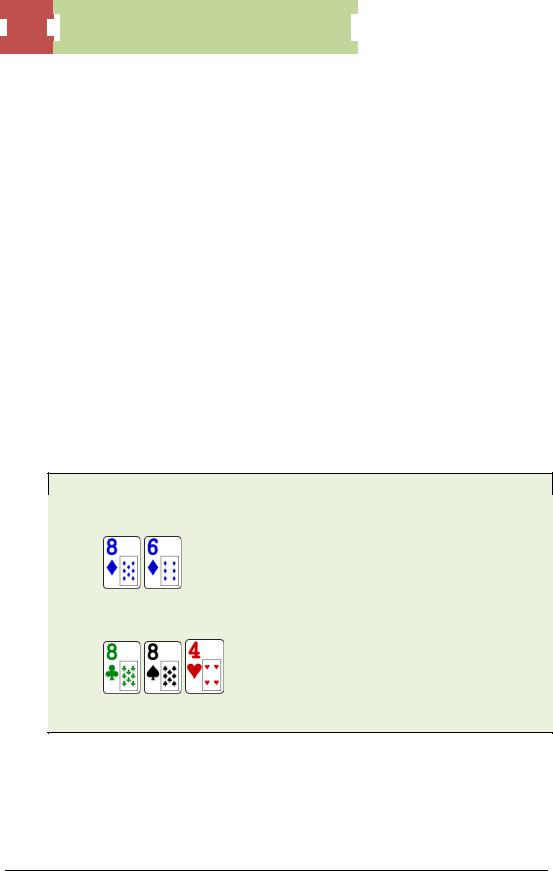
 69
69  Postflop: Time to Play Poker
Postflop: Time to Play Poker
Paired Flops
When a player check-calls your c-bet on paired flops, he almost always has a pocket pair. He will sometimes check-call with A-high as well. Knowing this, if a player calls your flop bet, be ready to fire a lot of turns. If he raises the turn bet, it’s almost never a bluff, so just fold unless you beat trips.
Unless your opponent is aggressive, calling a turn raise with a high pocket pair is usually burning money. You aren’t likely going to get exploited in this situation because players start to realize that bluffing overpairs in no-limit holdem is a very good way to lose money. If you feel your opponent is raising you a lot in this spot, do not 3-bet him. Call the turn and call the river.
Raising With a Gutshot
On a paired flop where there is a straight draw possible, a raise from an aggressive Villain will likely be a bluff. His range includes numerous gutshots and open-ended straight draws. While they have some equity in the pot, they can’t profitably check-call. So they check-raise.
100 NL – 6 max. 100BB effective stacks.
You open raise to $3 from the button with
and a good LAG player calls from the small blind. The flop is
and he checks. You bet $5 into a $7 pot. He raises to $15. What’s his range?
Villain’s range now includes more gutshots like 76s, 75s and 65s. He will more likely raise with these hands as opposed to a random hand like 97 diamonds because if you call, he still has outs. He could also have slow-played QQ-AA, although they make up a small percentage of his range since he would re-raise with them pre-flop. If he slow-played them pre-flop, he’s not likely to go crazy on a flop where he might be drawing dead.
© 2010 Aaron Davis and Tri Nguyen - All Rights Reserved.
http://www.DailyVariance.com
69
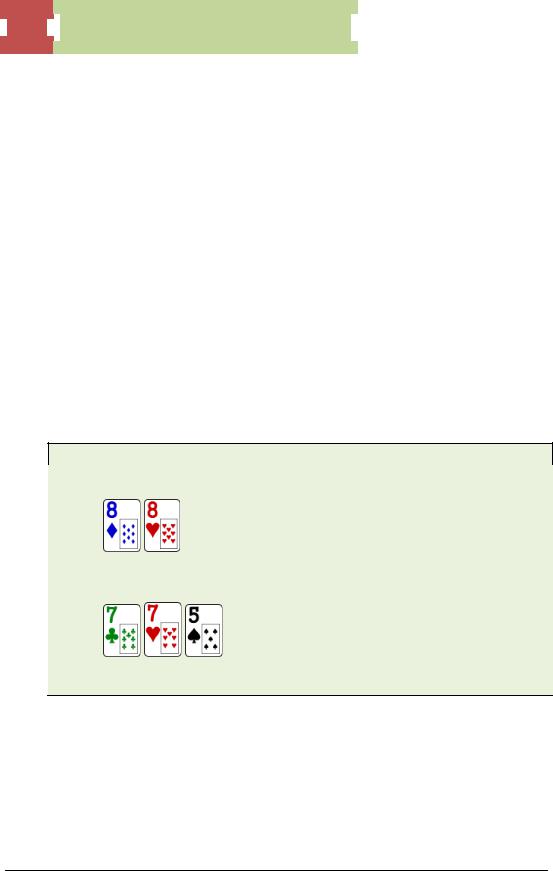
 70
70  Postflop: Time to Play Poker
Postflop: Time to Play Poker
Pocket pairs like 55-77 are also rare because Villain would check-call with them. So, what do you do?
Without an aggressive history, calling here is fine. However, for some opponents, a small 3-bet is better. There are many reasons for this. It can induce a bluff, though that’s a little too optimistic. A more important reason is that it’s a type of flop where opponents like to check-raise, so 3-betting here balances out the times when you don’t have trips, which is often. Showing that you 3-bet here sometimes with trips allows you to 3-bet bluff in future hands.
If he’s the type of player who will shut down once you call his check-raise, you can elect to call his flop check-raise instead of 3-betting and try to take it down on the turn or river.
Getting Check-Raised on a Paired Flop
As shown in the previous example, a check-raise on a paired flop is usually a bluff. Most players have a polarized range toward really strong hands and complete bluffs—with the latter being much more prominent.
100 NL – 6 max. 100BB effective stacks.
Suppose you open raise to $3 from the button with
A good TAG calls from the small blind. The flop is
You bet $5 into a $7 pot. He raises to $15. What’s his range?
Villain is not going to have a strong hand here often. However, since you opened from the BTN, your range will be wide and weak. Any decent TAG knows that. With that in mind, most players tend to slow-play a 7 here—hoping that you improve on the turn or river. With 88-TT, he’ll most likely just check-call the flop to keep the pot small. So, the only legitimate hands he can check-raise with here are JJ-AA. However, there are many more straight draws and random bluffs in his range. Thus, we should call his flop check-raise.
© 2010 Aaron Davis and Tri Nguyen - All Rights Reserved.
http://www.DailyVariance.com
70

 71
71  Postflop: Time to Play Poker
Postflop: Time to Play Poker
Since your hand has decent showdown value, you don’t want to turn it into a bluff by 3- betting. If Villain bets again on the turn, you can safely fold.
One interesting thing regarding these two examples is the construction of your range after you bet. You balance your flop range by 3-betting with trips+ and air, and call with your marginal hands and super nuts hands such as quads or boats. At the same time, if you don’t balance these holdings well, your opponents might catch up and think you only call with marginal holdings and continue to put pressure on you. It is unlikely that they do, so you don’t have to worry about it that much. However, as you move up in stakes
(5/10NL+), you should consider calling the flop check-raise more often with any holding that you want to continue with, since calling with the majority of your range is a little easier to balance than 3-betting some hands and calling others.
One important note regarding the board texture on a paired flop is that a check-raise is more believable if the flop is TT6 rather than 223, since a ten is more often in your opponent’s pre-flop range than a two.
3-Bet Pots
In 3-bet pots, Villain’s flop calling range is similar to that of single-raised pots. Villain’s calling range on the flop consists of mostly middle pocket pairs and occasionally AK/AQ that he didn’t 4-bet with. Knowing this, we should double-barrel bluff the turn if we pick up some type of draw. Most of his hands will not withstand a second strong barrel.
Let’s turn our attention to the following hand.
© 2010 Aaron Davis and Tri Nguyen - All Rights Reserved.
http://www.DailyVariance.com
71
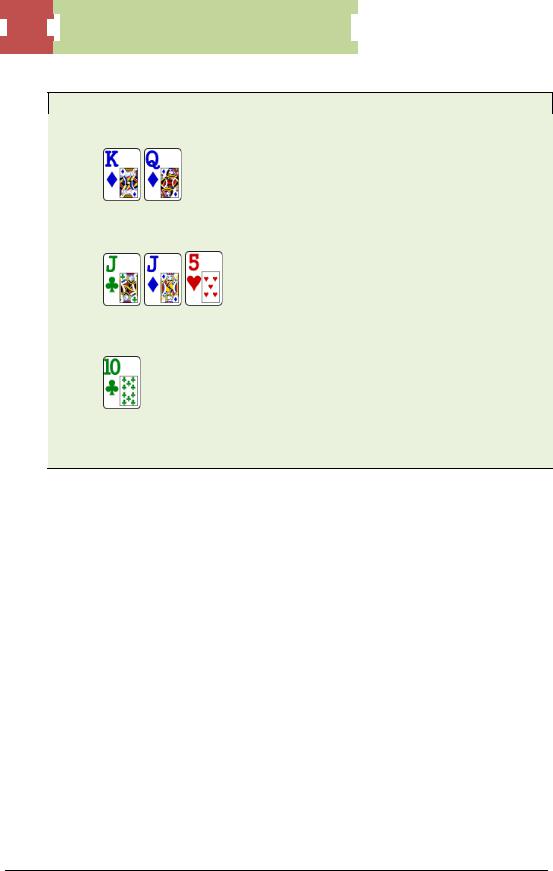
 72
72  Postflop: Time to Play Poker
Postflop: Time to Play Poker
100 NL – 6 max. 100BB effective stacks.
A TAG player open-raises to $3 from the button and you 3-bet to $10 with
from the big blind. He calls and the flop is
You c-bet $17 into a pot of $20.50 and he calls. The turn is a
You’ve picked up an open-ended straight draw. The pot is $54.50 and you have $73 left. Now what?
With 100BB stacks, you should bet strong and call off the rest if he jams. A large part of his flop calling range consists of 66-TT, 5x and sometimes Ace-high. A turn bet will fold out most of those hands (except TT, of course), making this a very profitable play. If he calls with Jx, you can still draw to your straight. There’s also too much dead money out there to check-fold. Unless the turn bet is really small, you can’t check-call a turn bet due to incorrect odds.
If stacks were deeper (125BB+), I would bet-fold turn. An amount around 1/2- or 3/5-pot is good. You are rarely getting bluff-shoved in this spot, so you can safely fold to a raise.
One more example.
© 2010 Aaron Davis and Tri Nguyen - All Rights Reserved.
http://www.DailyVariance.com
72
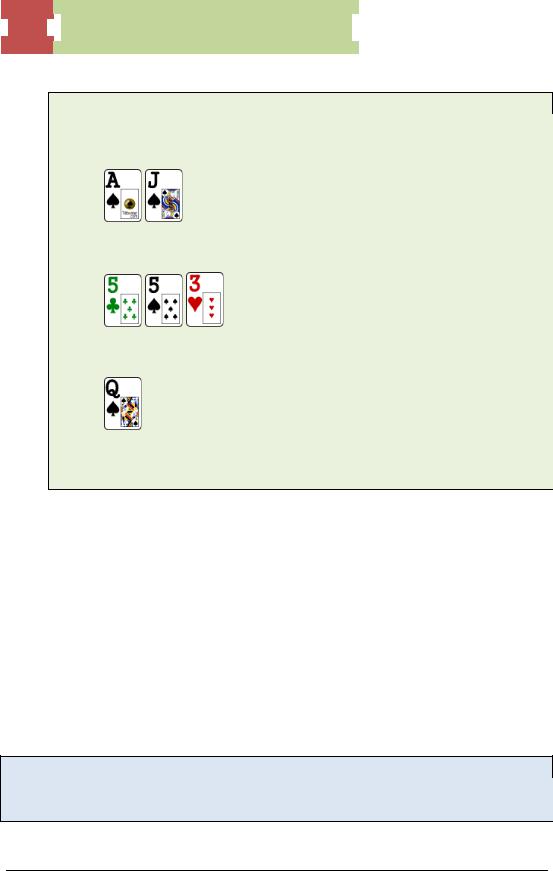
 73
73  Postflop: Time to Play Poker
Postflop: Time to Play Poker
100 NL – 6 max. 100BB effective stacks.
A LAG player open raises to $3 from the button, and you 3-bet to $10 from the BB with
He calls. The flop is
You bet $17 into $20.50 and he calls. The turn is a
and you now have a flush draw with overcards. The pot is $54.50 and you have $73 left. Do you bet or check?
You should bet. Most of his flop calling range consists of 66-JJ. QQ+ makes up a very small part of his range because he would have 4-bet them pre-flop. Had he slow-played them, he would have definitely check-raised the flop, since you don’t have a 5 in your range as often because it’s a 3-bet pot. So bet big to commit yourself, and call if he shoves. You can also over-bet all-in if over-betting is a part of your game. If over-betting is not part of your game, bet what you normally bet here with with Qx+ and call it off. Of course, don’t bet so small that you are getting incorrect odds to call against a shove.
A 1/2- to 3/4-pot bet has huge fold equity against his likely range, and if called, you can still make your flush. If he’s the type to float on these boards, a check-raise all-in is another option. However, you do run the risk of him checking behind all his medium pairs. Once Villain checks behind, he will be more likely to call a river bluff.
Important Note: Don’t bet so small on the turn that he can just raise all-in with a hand like 99. Increase your fold equity as much as possible by betting more than half-pot and showing him that you’re committed to the hand.
© 2010 Aaron Davis and Tri Nguyen - All Rights Reserved.
http://www.DailyVariance.com
73
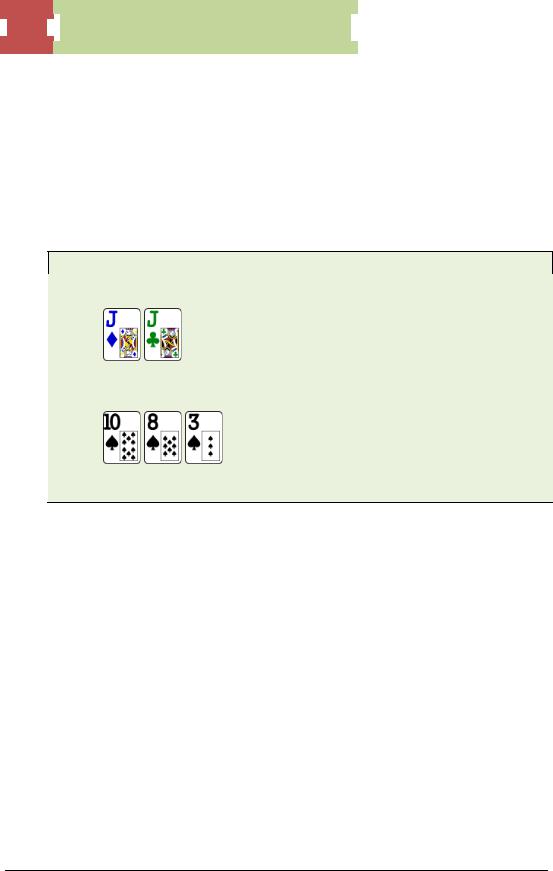
 74
74  Postflop: Time to Play Poker
Postflop: Time to Play Poker
Monotone Boards
Monotone boards have an interesting effect on people—they slow down the action a lot.
Players don’t often shove their stacks in with AcAd on T87 monotone spades, compared to AcAd on T87 with two spades. On monotone boards, there are fewer draws that your opponent can have when he shoves his stack in. Either he has the nut-flush draw or a strong made hand.
100 NL – 6 max. 100BB effective stacks.
Say we open-raise to $3.50 with
from the CO and a good TAG calls from the SB. The flop is
He checks and you bet $6 into $8. He raises to $20. What’s your play?
It is almost never correct to get it in here. Your best options are to either call the raise and fold to a turn bet if he continues aggression, or just fold now because you’re really only beating a bluff.
Keep in mind that he will rarely have a hand like T8o or ATo because most people don’t call pre-flop raises OOP with off-suit hands. This takes away the likelihood of him having a lone A, K, Q or J of spades in his range and decreases his semi-bluffing range. Assuming he does have one of those cards, Villain will likely check-call the flop (except with the nutflush draw). So his value range includes a slow-played JJ+ with a spade, plus TT, 88 and sometimes 33. You’re way behind his value range, and barely ahead of his semi-bluffing range—not a great spot to shove your entire stack in.
© 2010 Aaron Davis and Tri Nguyen - All Rights Reserved.
http://www.DailyVariance.com
74
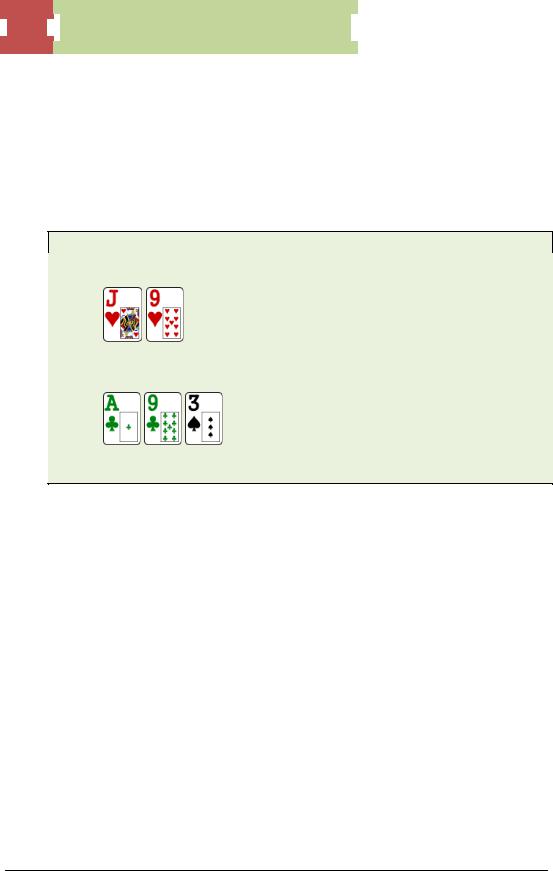
 75
75  Postflop: Time to Play Poker
Postflop: Time to Play Poker
Villain’s Perception of Your Range
Your betting frequency depends on a few things (equity, board texture and image). You generally should bluff more and value-bet less if Villain’s perception of your range is strong, and bluff less and value-bet more if it’s weak. Knowing what he thinks of your range allows you to determine the best course of action at any time.
100 NL – 6 max. 100BB effective stacks. You open-raise from the CO with
and Villain calls from the BB. The flop is
The default play is to bet here almost 100 percent of the time.
Villain’s perception of your range includes a lot of hands with an ace in them, and he’s right. You will also show up with sets, two pair, TT-KK and 9x. Although unlikely, betting might fold out TT-QQ. Betting also charges his draws, protects your hand and makes the hand easier to play.
Let’s look at another example.
© 2010 Aaron Davis and Tri Nguyen - All Rights Reserved.
http://www.DailyVariance.com
75
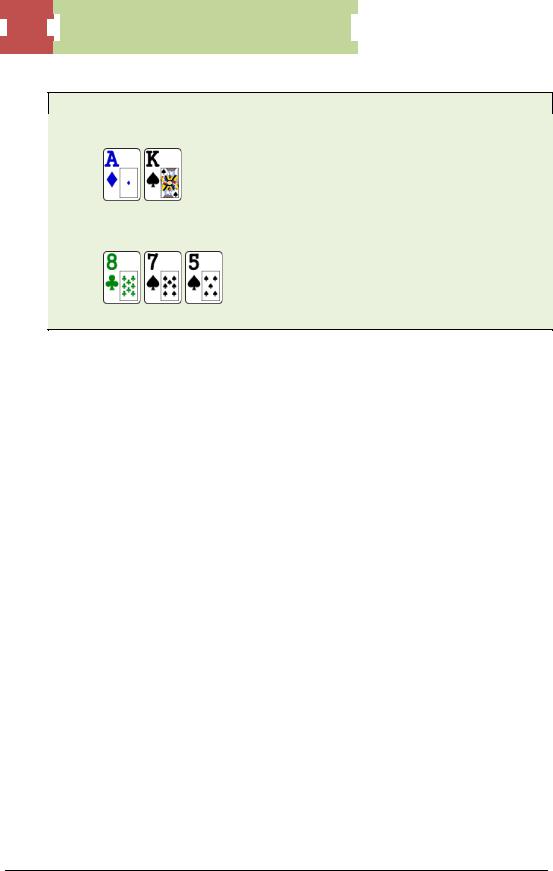
 76
76  Postflop: Time to Play Poker
Postflop: Time to Play Poker
100 NL – 6 max. 100BB effective stacks.
What if you have
on
Your perceived range doesn’t hit this flop as hard. Villain will likely put you on high cards more often than medium suited connectors, and may decide to call you down lighter, float or even bluff-raise you. In this scenario, it’s best to check behind against an aggressive player who can check-raise this flop with a wide range.
© 2010 Aaron Davis and Tri Nguyen - All Rights Reserved.
http://www.DailyVariance.com
76
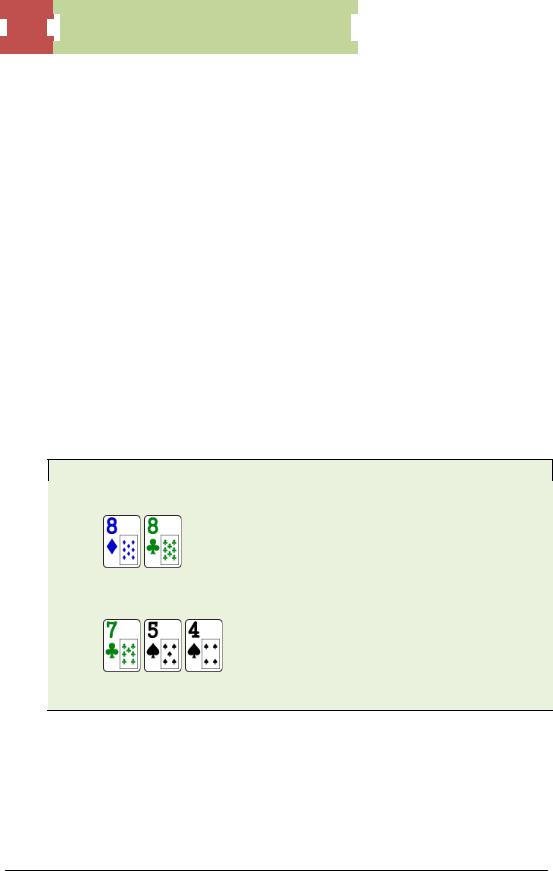
 77
77  Postflop: Time to Play Poker
Postflop: Time to Play Poker
Leading
Leading, aka donk-betting, is betting into the pre-flop raiser. Few players donk-bet, and even fewer do it effectively. Donk-betting has many purposes—to steal the pot, to induce a bluff, to build a pot, to slow down the pre-flop raiser, etc.
The first time you lead should be with a weak made hand or draw. Most players in the lower limits don’t react well to leads and either fold or call. Decent players understand that you would have shown aggression pre-flop or gone for a check-raise on the flop with a strong hand. So they’ll either call lighter on the flop or bluff-raise with weak pairs, overcards, and gutshots, and you’ll need to fire a second barrel to win.
Polarize Your Leading Range
You generally want to lead with strong made hands that can easily call a raise, or with draws (pair + flush draw, flush draw, open-ended, overcards + open-ended, gutshot + opened-ended, gutshot). This cannot be emphasized enough. There is nothing worse than leading with JQ on KJ3 rainbow, getting raised by the pre-flop raiser, and not knowing what to do. Don’t put yourself into these difficult situations without a plan.
100 NL – 6 max. 100BB effective stacks.
Say you call a button raise from the blinds with
It’s heads-up and the flop is
What do you do?
This is a good spot to lead. Check-calling makes the hand tough to play because there are a lot of turn cards that will leave you not knowing what to do. Leading will often take the pot down. If you get raised, you should fold. Pocket eights are actually at the bottom of your range on the flop, since you can have two pair, sets, and a straight in your range. You can also have a strong combo draw that wants to take the bet-3-bet line.
© 2010 Aaron Davis and Tri Nguyen - All Rights Reserved.
http://www.DailyVariance.com
77
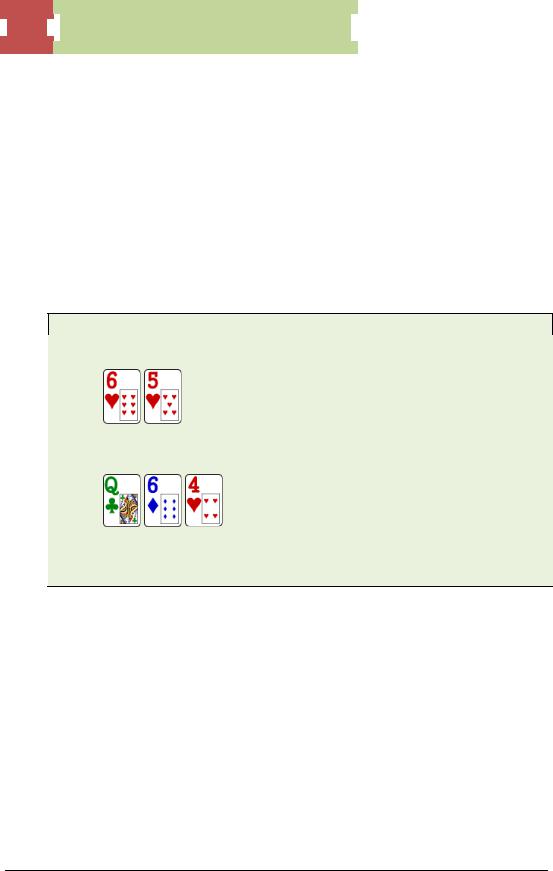
 78
78  Postflop: Time to Play Poker
Postflop: Time to Play Poker
If he calls your leads, you should consider betting on any turn, because he’s probably calling the flop with a naked flush draw or a smaller pair. Checking allows him to bluff, and it’s tough for you to call because he can have other strong holdings as well. It’s a difficult situation, but betting is generally superior to check-calling or check-folding here.
Single-Raised Multi-Way Pots
Consider leading with middle and bottom pairs in a single-raised multi-way pot. It’ll be too hard to profitably check-call with medium pairs. Leading also puts the player behind you in a difficult situation. He has to worry about you showing up with a strong hand, as well as the other player in the pot. This is evident in our next example.
100 NL – 6 max. 100BB effective stacks.
Button open raises to $4, SB calls and you call from the BB with
The flop is
SB checks to you and you lead for 3/4-pot. Button tanks and folds. SB folds as well.
Check-calling is sub-optimal. The button will c-bet nearly 100-percent of his range because he has the betting initiative on a very dry board. Although we may sometimes have the best hand, there are plenty of turn scare cards that Villain can barrel off on (9 or higher). Leading here forces the Button into an awkward spot. Even if he thinks you’re leading light here, he’ll have to worry about the SB waking up with a strong hand. If you bet the flop and either opponent raises, then you can safely fold, knowing you’re beat.
Who to Lead Against
Generally, you want to lead into straightforward players who are passive. Your prime targets are:
© 2010 Aaron Davis and Tri Nguyen - All Rights Reserved.
http://www.DailyVariance.com
78
